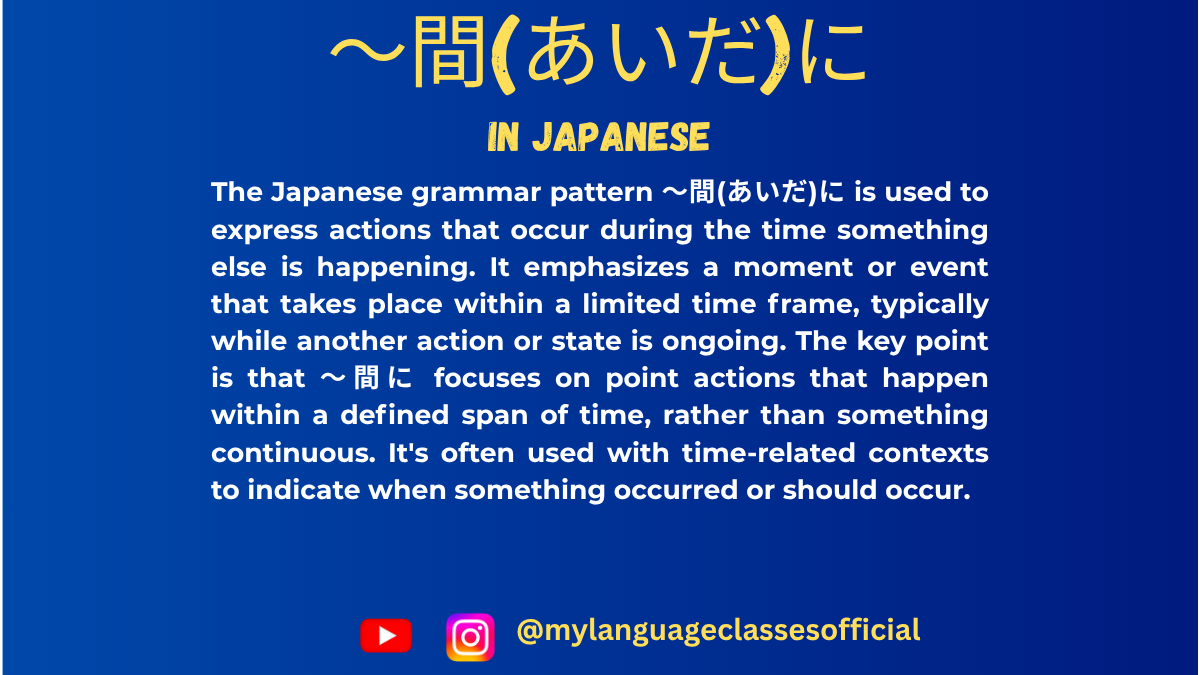Your cart is currently empty!
Tag: Japanese sentence structure
-
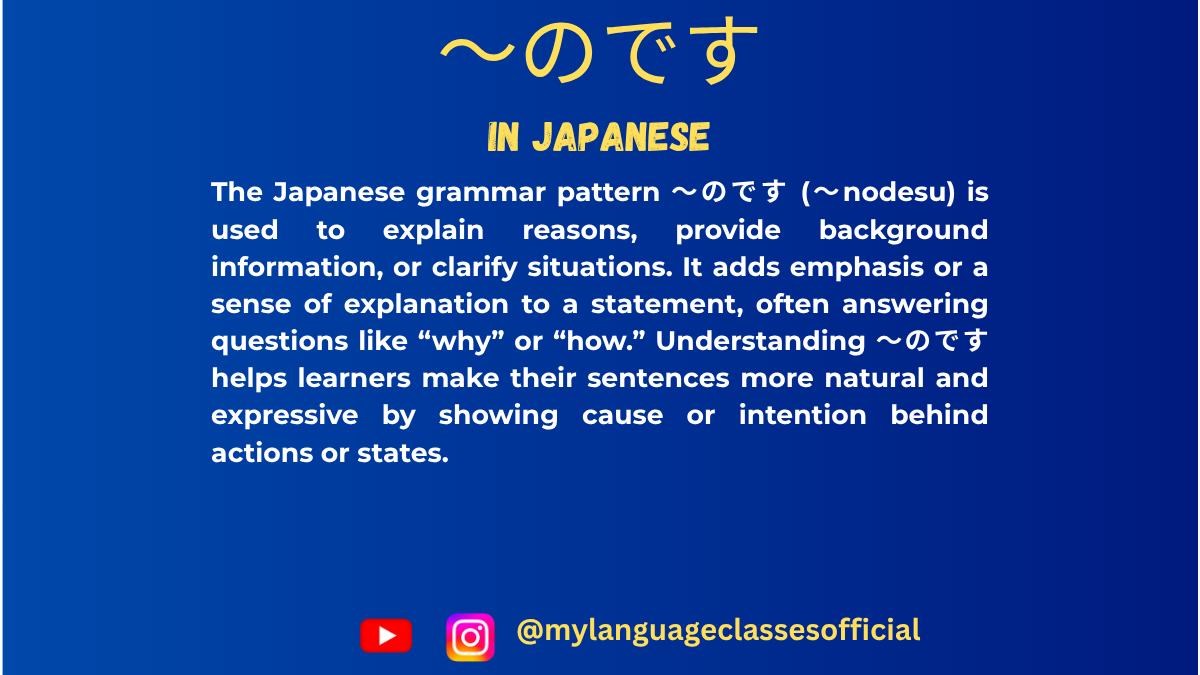
Understanding 〜のですin Japanese | My Language Classes
Understanding 〜のです in Japanese
The 〜のです (or its casual form 〜んです) is a grammatical structure in Japanese used to give explanations, seek clarifications, or express emotions. It adds a sense of reasoning to a statement and is often used in both spoken and written Japanese.
Formation of 〜のです
1. Formation with Verbs
- Affirmative (Present/Future):
- Dictionary form + のです / んです
- Example: 食べるのです (taberu no desu)
- Negative (Present/Future):
- ない-form + のです / んです
- Example: 食べないのです (tabenai no desu)
- Past Affirmative:
- た-form + のです / んです
- Example: 食べたのです (tabeta no desu)
- Past Negative:
- なかった-form + のです / んです
- Example: 食べなかったのです (tabenakatta no desu)
2. Formation with Nouns
- Affirmative:
- Noun + なのです / なんです (casual)
- Example: 学生なのです (gakusei nano desu)
- Negative:
- Noun + ではないのです / じゃないんです (casual)
- Example: 学生ではないのです (gakusei dewa nai no desu)
3. Formation with Adjectives
- i-Adjectives:
- そのまま + のです / んです
- Example: うれしいのです (ureshii no desu)
- Negative: うれしくないのです (ureshikunai no desu)
- na-Adjectives:
- な + のです / んです
- Example: 静かなのです (shizuka nano desu)
- Negative: 静かではないのです (shizuka dewa nai no desu)
Usage of 〜のです
The 〜のです form is used in various situations. Below are the key contexts in which it is used:
1. Providing an Explanation
This form is often used to explain reasons behind actions or situations.
- Example: どうして遅れたのですか? (Why were you late?)
- Example: 雨が降っていたのです。(It was raining.)
2. Seeking Clarification or Confirmation
When you are trying to confirm or seek clarification about something.
- Example: その本はあなたのものなのですか? (Is that book yours?)
3. Expressing a Justification
To justify an action or event.
- Example: 宿題が多かったのです。(I had a lot of homework.)
4. Making a Statement More Emphatic
Using のです makes the statement more formal or assertive.
- Example: 私が行くのです。(I will go.)
5. Stating a Fact with Emphasis
- Example: これはとても大切なのです。(This is very important.)
Other Usage of 〜のです
Situations where 〜のです is used
- Giving explanations or reasons
- Asking for explanations or clarifications
- Expressing emotions such as surprise or concern
- Emphasizing a statement
- Giving background information
- Making an indirect request
- Softening a statement
- Seeking confirmation
- Expressing curiosity
- Describing an unusual situation
List of Verbs with their 〜のです Form
Verb (Dictionary Form) 〜のです Form Example Sentence 1 Romaji Meaning Example Sentence 2 Romaji Meaning 食べる (taberu) 食べるのです これは毎日食べるのです。 Kore wa mainichi taberu no desu. I eat this every day. 彼は魚を食べるのですか? Kare wa sakana o taberu no desu ka? Does he eat fish? 行く (iku) 行くのです 学校へ行くのです。 Gakkou e iku no desu. I am going to school. どこへ行くのですか? Doko e iku no desu ka? Where are you going? 来る (kuru) 来るのです 明日、彼が来るのです。 Ashita, kare ga kuru no desu. He is coming tomorrow. どうして来るのですか? Doushite kuru no desu ka? Why is he coming? 見る (miru) 見るのです 彼はテレビを見るのです。 Kare wa terebi o miru no desu. He watches TV. 何を見ているのですか? Nani o mite iru no desu ka? What are you watching? 書く (kaku) 書くのです 彼女は日記を書くのです。 Kanojo wa nikki o kaku no desu. She writes a diary. 何を書いているのですか? Nani o kaite iru no desu ka? What are you writing? 話す (hanasu) 話すのです 先生は日本語を話すのです。 Sensei wa nihongo o hanasu no desu. The teacher speaks Japanese. 彼と何を話していたのですか? Kare to nani o hanashite ita no desu ka? What were you talking about with him? 買う (kau) 買うのです 私は新しい車を買うのです。 Watashi wa atarashii kuruma o kau no desu. I will buy a new car. 何を買ったのですか? Nani o katta no desu ka? What did you buy? 泳ぐ (oyogu) 泳ぐのです 彼は毎朝泳ぐのです。 Kare wa maiasa oyogu no desu. He swims every morning. どこで泳ぐのですか? Doko de oyogu no desu ka? Where do you swim? 勉強する (benkyou suru) 勉強するのです 私は毎日日本語を勉強するのです。 Watashi wa mainichi nihongo o benkyou suru no desu. I study Japanese every day. 何を勉強しているのですか? Nani o benkyou shite iru no desu ka? What are you studying? 働く (hataraku) 働くのです 彼は銀行で働くのです。 Kare wa ginkou de hataraku no desu. He works at a bank. どこで働いているのですか? Doko de hataraite iru no desu ka? Where do you work? 走る (hashiru) 走るのです 彼は毎朝公園で走るのです。 Kare wa maiasa kouen de hashiru no desu. He runs in the park every morning. どのくらい走るのですか? Dono kurai hashiru no desu ka? How far do you run? 歌う (utau) 歌うのです 彼女はとても上手に歌うのです。 Kanojo wa totemo jouzu ni utau no desu. She sings very well. どんな歌を歌うのですか? Donna uta o utau no desu ka? What kind of songs do you sing? 覚える (oboeru) 覚えるのです 私は新しい単語を覚えるのです。 Watashi wa atarashii tango o oboeru no desu. I memorize new words. どうやって覚えるのですか? Dou yatte oboeru no desu ka? How do you memorize them? 遊ぶ (asobu) 遊ぶのです 子供たちは公園で遊ぶのです。 Kodomotachi wa kouen de asobu no desu. The children play in the park. どこで遊ぶのですか? Doko de asobu no desu ka? Where do they play?
More Example Sentences
- 明日はテストがあるのです。
Ashita wa tesuto ga aru no desu.
(There is a test tomorrow.) - 彼女は病気なのです。
Kanojo wa byouki na no desu.
(She is sick.) - この本は大切なのです。
Kono hon wa taisetsu na no desu.
(This book is important.)
4. 彼は昨日学校を休んだのです。
Kare wa kinō gakkō o yasunda no desu.
(He was absent from school yesterday.)5. どうしてそんなに疲れているのですか?
Dōshite sonna ni tsukarete iru no desu ka?
(Why are you so tired?)6.この時計は祖父からもらったのです。
Kono tokei wa sofu kara moratta no desu.
(I received this watch from my grandfather.)7. 彼女は日本に行くのです。
Kanojo wa Nihon ni iku no desu.
(She is going to Japan.)8. 電車が遅れたのです。
Densha ga okureta no desu.
(The train was delayed.)9.その映画はとても感動的だったのです。
Sono eiga wa totemo kandō-teki datta no desu.
(That movie was very emotional.)10.雨が降っていたのです。
Ame ga futte ita no desu.
(It was raining.)
Things to Keep in Mind
- のです is often shortened to んです in spoken language.
- It is more polite and formal than a direct statement.
- Used in interrogative sentences to seek more information.
- Often used in written explanations and discussions.
Fill in the Blanks
- なぜ学校を休んだ____?
- 彼女は来ない____。
- 私は先生に質問した____。
- どうして泣いている____か?
- 彼は何も言わなかった____。
- あなたが怒っているのは知っている____。
- 昨日、帰りが遅くなった____。
- この本を読んだことがある____か?
- 今日は早く寝たほうがいい____よ。
- 彼がそんなことをするはずがない____。
Conclusion
The 〜のです form is an essential grammar structure that allows Japanese speakers to explain reasons, seek clarifications, and emphasize statements naturally. Mastering its usage will significantly improve your fluency in Japanese communication. Practice using のです in different situations, and you’ll soon find yourself speaking more like a native!
If you enjoyed this lesson, be sure to check out more posts like this on my blog at My Language Classes. Don’t forget to subscribe my YouTube channel and follow me on Instagram for the latest language learning tips and lessons. Leave a comment below to share your thoughts, or ask any questions you have about nouns.
Happy learning! 😊
- Affirmative (Present/Future):
-
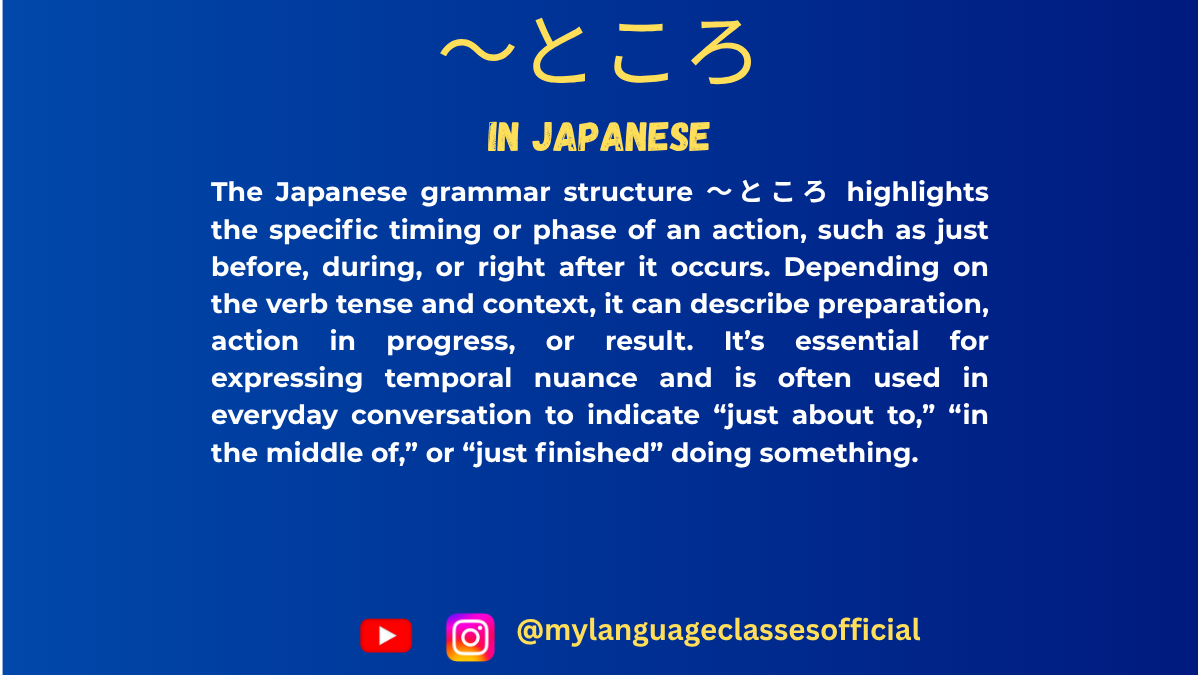
How to Use 〜ところ in Japanese | My Language Classes
Using 〜ところ Form in Japanese
The 〜ところ form is a crucial grammatical structure in Japanese that expresses different stages of an action. It helps indicate whether an action is about to happen, is in progress, or has just been completed. This blog post will cover the formation of 〜ところ for all three verb groups, its various uses, and provide example sentences, things to keep in mind, exercises, and a conclusion.
Formation of 〜ところ Form
Group 1 (Ichidan Verbs)
For ichidan (一段) verbs, remove る from the dictionary form and add the appropriate auxiliary:
- Before the action: 〜るところ
- During the action: 〜ているところ
- After the action: 〜たところ
Example:
- 食べる (taberu – to eat)
- Before: 食べるところ (taberu tokoro)
- During: 食べているところ (tabete iru tokoro)
- After: 食べたところ (tabeta tokoro)
Group 2 (Godan Verbs)
For godan (五段) verbs, use the same rules as ichidan verbs but conjugate accordingly:
- Before the action: Dictionary form + ところ
- During the action: て-form + いるところ
- After the action: た-form + ところ
Example:
- 読む (yomu – to read)
- Before: 読むところ (yomu tokoro)
- During: 読んでいるところ (yonde iru tokoro)
- After: 読んだところ (yonda tokoro)
Group 3 (Irregular Verbs)
For irregular verbs like する and くる:
- する (suru – to do)
- Before: するところ (suru tokoro)
- During: しているところ (shite iru tokoro)
- After: したところ (shita tokoro)
- くる (kuru – to come)
- Before: くるところ (kuru tokoro)
- During: きているところ (kite iru tokoro)
- After: きたところ (kita tokoro)
Usage of 〜ところ
Situations where 〜ところ is used:
Situation Form Used Example Right before an action るところ 今から寝るところです。 (I’m just about to sleep.) In the middle of an action ているところ ちょうど宿題をしているところです。 (I am in the middle of doing my homework.) Just after an action たところ ちょうどご飯を食べたところです。 (I just finished eating.) To indicate an important moment る・ている・たところ 試験を受けるところだった。(I was just about to take the exam.) When explaining a sequence of events たところ 先生に聞いたところ、すぐに答えがわかった。(When I asked the teacher, I immediately understood the answer.)
Example Sentences
- 電車が出発するところです。
Densha ga shuppatsu suru tokoro desu.
(The train is about to depart.) - 彼は今、電話しているところです。
Kare wa ima, denwa shite iru tokoro desu.
(He is on the phone right now.) - ちょうど昼ご飯を食べたところです。
Choudo hirugohan o tabeta tokoro desu.
(I just finished eating lunch.) - 飛行機が今にも飛ぶところです。
Hikouki ga ima ni mo tobu tokoro desu.
(The airplane is just about to take off.) - 友達と話しているところでした。
Tomodachi to hanashite iru tokoro deshita.
(I was in the middle of talking with my friend.) - 彼に聞いたところ、すぐに答えてくれました。
Kare ni kiita tokoro, sugu ni kotaete kuremashita.
(When I asked him, he answered immediately.) - ちょうど今、家を出るところです。
Choudo ima, ie o deru tokoro desu.
(I am just about to leave home.) - 映画を見ているところです。
Eiga o mite iru tokoro desu.
(I am in the middle of watching a movie.) - 買い物が終わったところです。
Kaimono ga owatta tokoro desu.
(I just finished shopping.) - 勉強するところだったのに、友達が来ました。
Benkyou suru tokoro datta noni, tomodachi ga kimashita.
(I was about to study, but my friend came.)
Things to Keep in Mind
- 〜ところ emphasizes timing rather than the state of an action.
- Be careful not to confuse たところ with たばかり; たところ emphasizes immediate completion.
- ているところ is often used to explain ongoing actions.
- This form is frequently used with words like ちょうど (exactly, just), 今 (now), まさに (precisely).
Fill in the Blanks
- ちょうど今、映画を____ところです。
- 飛行機が____ところでした。
- 彼は電話を____ところです。
- 今、家を____ところです。
- 私は宿題を____ところだった。
- 友達が来たので、ちょうど出かける____だった。
- 先生に聞いた____、すぐに理解しました。
- 彼はまだ寝る____ではありません。
- ちょうどレポートを____ところでした。
- 仕事が終わった____です。
Answers
- 見ている
- 飛ぶ
- している
- 出る
- する
- ところ
- ところ
- ところ
- 書く
- ところ
Conclusion
The 〜ところ form is an essential grammar point that helps clarify the timing of an action. Whether something is about to happen, currently happening, or has just happened, understanding how to use 〜ところ correctly will significantly improve your Japanese fluency. Keep practicing, and soon this structure will become second nature in your conversations!
If you enjoyed this lesson, be sure to check out more posts like this on my blog at My Language Classes. Don’t forget to subscribe my YouTube channel and follow me on Instagram for the latest language learning tips and lessons. Leave a comment below to share your thoughts, or ask any questions you have about nouns.
Happy learning! 😊
-
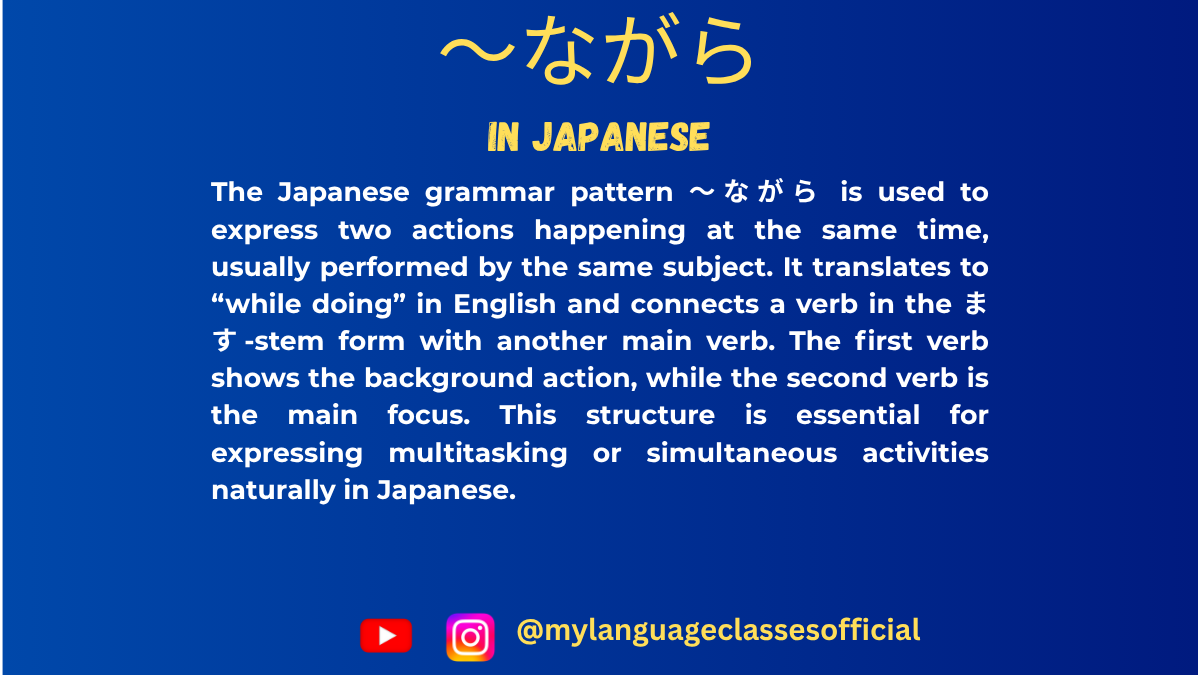
Using 〜ながら Form in Japanese | My Language Classes
〜ながら Form in Japanese
The 〜ながら (nagara) form is an essential Japanese grammar structure used to describe two actions happening simultaneously. It is widely used in both casual and formal conversations to indicate multitasking or actions occurring at the same time.
In this blog, we will explore the formation of 〜ながら for all three verb groups, its various usages, and a comprehensive list of verbs with example sentences. Additionally, we will provide a section with more example sentences, fill-in-the-blank exercises, key points to remember, and a conclusion.
Formation of 〜ながら for Different Verb Groups
Japanese verbs are categorized into three groups: Group 1 (Godan verbs), Group 2 (Ichidan verbs), and Group 3 (Irregular verbs). Each group follows a specific rule for forming 〜ながら.
1. Group 1 (Godan Verbs)
For Godan verbs, take the ます-stem of the verb and add ながら.
- Example Formation
- 話す (hanasu – to speak) → 話しながら (hanashinagara – while speaking)
- 書く (kaku – to write) → 書きながら (kakinagara – while writing)
2. Group 2 (Ichidan Verbs)
For Ichidan verbs, remove る from the dictionary form and add ながら.
- Example Formation
- 食べる (taberu – to eat) → 食べながら (tabenagara – while eating)
- 見る (miru – to see) → 見ながら (minagara – while watching)
3. Group 3 (Irregular Verbs)
There are only two irregular verbs in Japanese: する and くる.
- Example Formation
- する (suru – to do) → しながら (shiinagara – while doing)
- くる (kuru – to come) → きながら (kinagara – while coming)
Situations Where 〜ながら Form is Used
- Describing Two Simultaneous Actions
- 音楽を聞きながら勉強する (Ongaku o kikinagara benkyou suru) – Study while listening to music.
- Multitasking in Daily Life
- テレビを見ながらご飯を食べる (Terebi o minagara gohan o taberu) – Eat while watching TV.
- Speaking While Performing Another Action
- 笑いながら話す (Warainagara hanasu) – Talk while laughing.
- Contrasting Two Simultaneous Actions
- 悲しみながら笑う (Kanashiminagara warau) – Laugh while feeling sad.
- Working or Performing a Task While Doing Something Else
- 仕事をしながらコーヒーを飲む (Shigoto o shinagara koohii o nomu) – Drink coffee while working.
Verb List with 〜ながら Form and Example Sentences
Verb (Dictionary Form) 〜ながら Form Example Sentence (Japanese) Romaji English Translation 話す (hanasu) 話しながら (hanashinagara) 彼は笑いながら話しました。 Kare wa warainagara hanashimashita. He spoke while laughing. 書く (kaku) 書きながら (kakinagara) 先生は黒板に書きながら説明した。 Sensei wa kokuban ni kakinagara setsumei shita. The teacher explained while writing on the board. 読む (yomu) 読みながら (yominagara) 彼女は本を読みながら寝てしまった。 Kanojo wa hon o yominagara nete shimatta. She fell asleep while reading a book. 見る (miru) 見ながら (minagara) 子供たちはアニメを見ながら笑った。 Kodomotachi wa anime o minagara waratta. The children laughed while watching anime. 歩く (aruku) 歩きながら (arukinagara) 彼は音楽を聞きながら歩いた。 Kare wa ongaku o kikinagara aruita. He walked while listening to music. 食べる (taberu) 食べながら (tabenagara) 彼女はテレビを見ながら食べる。 Kanojo wa terebi o minagara taberu. She eats while watching TV. 泳ぐ (oyogu) 泳ぎながら (oyoginagara) 彼は海で泳ぎながら歌った。 Kare wa umi de oyoginagara utatta. He sang while swimming in the sea.
More Example Sentences
- 音楽を聞きながら勉強する。
Ongaku o kikinagara benkyou suru.
Study while listening to music. - コーヒーを飲みながらニュースを見る。
Koohii o nominagara nyuusu o miru.
Watch the news while drinking coffee. - 料理をしながらラジオを聞く。
Ryouri o shinagara rajio o kiku.
Listen to the radio while cooking. - 車を運転しながら歌う。
Kuruma o unten shinagara utau.
Sing while driving. - 宿題をしながら電話をする。
Shukudai o shinagara denwa o suru.
Talk on the phone while doing homework.
Fill in the Blanks Questions
- 本を______ながら、リラックスします。(読む)
- 音楽を______ながら、運転する。(聞く)
- 仕事を______ながら、テレビを見る。(する)
- ご飯を______ながら、友達と話す。(食べる)
- 日本語を______ながら、メモを取る。(勉強する)
Answers
- 読みながら (yominagara)
- 聞きながら (kikinagara)
- しながら (shiinagara)
- 食べながら (tabenagara)
- 勉強しながら (benkyou shinagara)
Things to Keep in Mind
- The subject of both actions must be the same.
- The ながら clause comes before the main action.
- ながら is used only for actions, not states.
Conclusion
The 〜ながら form is an important grammar structure in Japanese that allows smooth expression of simultaneous actions. By practicing with various verbs and sentences, you will become more fluent in using it naturally in conversations.
Keep practicing and incorporating 〜ながら into your daily Japanese studies!
If you enjoyed this lesson, be sure to check out more posts like this on my blog at My Language Classes. Don’t forget to subscribe my YouTube channel and follow me on Instagram for the latest language learning tips and lessons. Leave a comment below to share your thoughts, or ask any questions you have about nouns.
Happy learning! 😊
- Example Formation
-
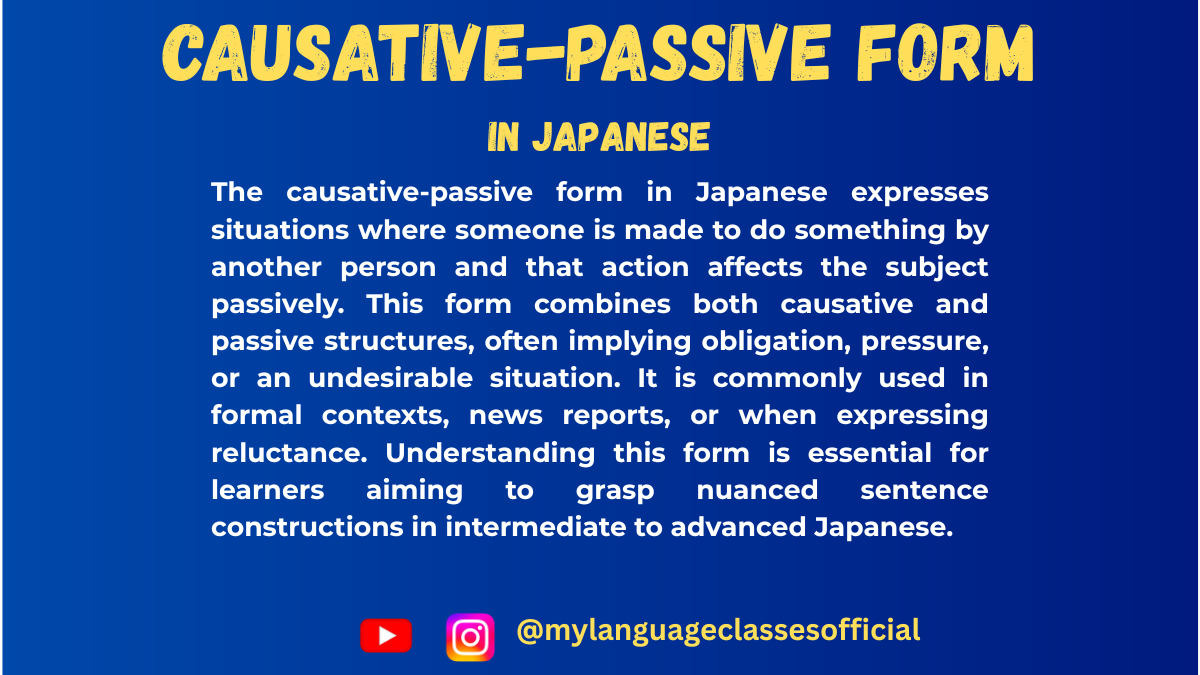
Causative-Passive Form of verbs in Japanese | My Language Classes
Causative-Passive Form in Japanese
The causative-passive form (使役受身, shieki ukemi) in Japanese is an important grammatical structure that conveys a sense of being forced or made to do something against one’s will. This form is frequently used in formal speech, written language, and storytelling.
Formation of Causative-Passive Verbs
To form the causative-passive form, we first conjugate the verb into its causative form and then change it into its passive form.
Group 1 (Ichidan) Verbs
- Convert the verb to its causative form:
- Drop る and add させる (for positive causative)
- Convert the causative form to its passive form:
- Drop る and add られる
Example:
- 食べる (たべる, taberu) → 食べさせる (たべさせる, tabesaseru) → 食べさせられる (たべさせられる, tabesaserareru)
Group 2 (Godan) Verbs
- Convert the verb to its causative form:
- Change the u sound to a and add せる
- Convert the causative form to its passive form:
- Change せる to せられる or される
Example:
- 書く (かく, kaku) → 書かせる (かかせる, kakaseru) → 書かせられる (かかせられる, kakaserareru)
Group 3 (Irregular) Verbs
- する → させる → させられる
- くる → こさせる → こさせられる
Usage of the Causative-Passive Form
The causative-passive form is primarily used in the following situations:
- Expressing Forced Action
- “I was made to do something.”
- Indicating an Unwanted Situation
- “I ended up in an unfavorable situation.”
- In Formal Writing & Passive Expressions
- Commonly used in news articles, literature, and business settings.
- Indirect Authority or Control
- Used when talking about school, work, or hierarchical relationships.
- Apologizing or Explaining a Difficult Situation
- “I was put in a tough spot.”
List of Causative-Passive Verbs with Examples
Verb Causative-Passive Form Example Sentence 1 Romaji English Meaning Example Sentence 2 Romaji English Meaning 書く (kaku) 書かせられる (kakaserareru) 先生に作文を書かせられた。 Sensei ni sakubun o kakaserareta. I was forced to write an essay by the teacher. 上司にレポートを書かせられた。 Joushi ni repooto o kakaserareta. I was made to write a report by my boss. 食べる (taberu) 食べさせられる (tabesaserareru) 嫌いな野菜を食べさせられた。 Kirai na yasai o tabesaserareta. I was made to eat vegetables I dislike. 子供のころ、嫌いな魚を食べさせられた。 Kodomo no koro, kirai na sakana o tabesaserareta. When I was a child, I was made to eat fish I disliked. 話す (hanasu) 話させられる (hanasaserareru) 上司に長いスピーチを話させられた。 Joushi ni nagai supiichi o hanasaserareta. I was made to give a long speech by my boss. 友達に嘘を話させられた。 Tomodachi ni uso o hanasaserareta. I was forced to tell a lie by my friend. 読む (yomu) 読まさせられる (yomasaserareru) 先生に長い本を読まさせられた。 Sensei ni nagai hon o yomasaserareta. I was forced to read a long book by the teacher. 上司に新聞を読まさせられた。 Joushi ni shinbun o yomasaserareta. I was made to read the newspaper by my boss. 行く (iku) 行かさせられる (ikasaserareru) 先生に学校に行かさせられた。 Sensei ni gakkou ni ikasaserareta. I was made to go to school by the teacher. 父に病院に行かさせられた。 Chichi ni byouin ni ikasaserareta. I was forced to go to the hospital by my father. More Example Sentences
- 先生に漢字を100回書かせられた。
Sensei ni kanji o hyakkai kakaserareta.
I was forced to write kanji 100 times by the teacher. - 母に部屋を掃除させられた。
Haha ni heya o souji saserareta.
I was made to clean my room by my mother. - 部長に遅くまで働かさせられた。 Buchou ni osoku made hatarakasaserareta. I was made to work late by my manager.
- 先生に難しい問題を解かさせられた。 Sensei ni muzukashii mondai o tokasaserareta. I was forced to solve a difficult problem by the teacher.
- 親に謝らさせられた。 Oya ni ayamarasaserareta. I was made to apologize by my parents.
Conclusion
The causative-passive form is a useful grammatical structure for expressing situations where someone is forced to act against their will. While it is more common in written and formal contexts, mastering this form will greatly enhance your Japanese comprehension and expression skills. Keep practicing with different verbs and real-life situations to fully grasp the nuances of this construction!
If you enjoyed this lesson, be sure to check out more posts like this on my blog at My Language Classes. Don’t forget to subscribe my YouTube channel and follow me on Instagram for the latest language learning tips and lessons. Leave a comment below to share your thoughts, or ask any questions you have about nouns.
Happy learning! 😊
- Convert the verb to its causative form:
-
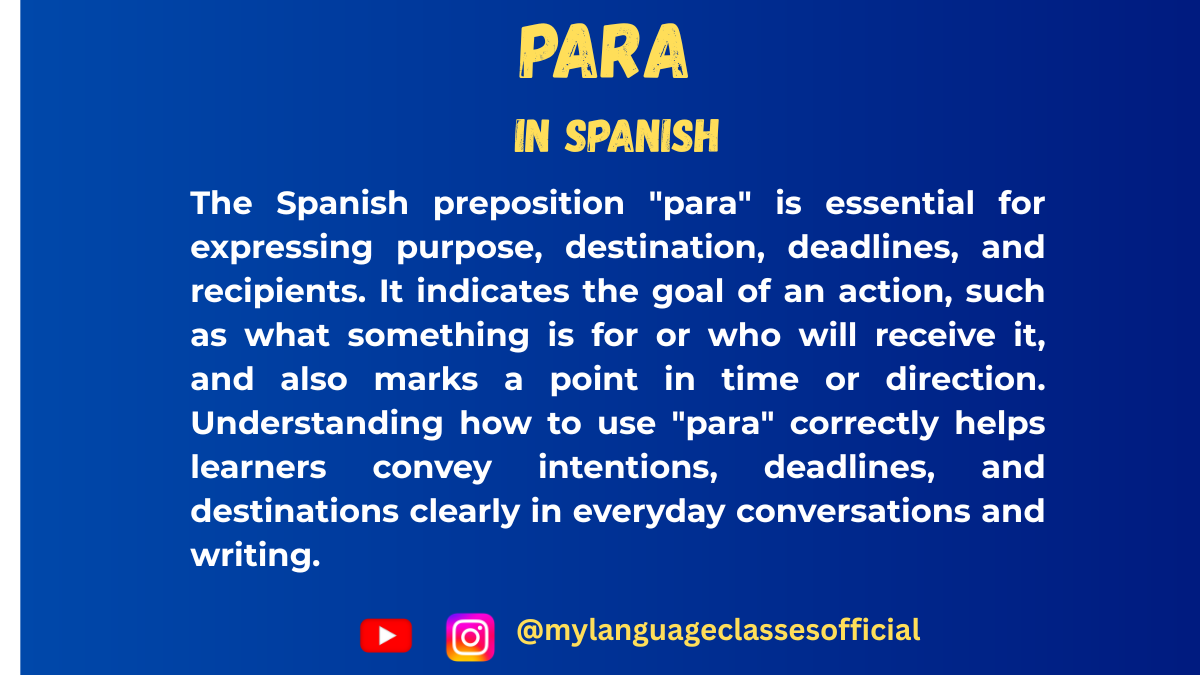
Everything You Need to Know About PARA in Spanish
When learning Spanish, one of the trickiest aspects is understanding the difference between “por” and “para.” While both can translate to “for” in English, they serve different purposes in Spanish. This article will focus on “para”—its uses, common expressions, and grammatical rules.
Uses of PARA in Spanish
“Para” is generally used to indicate purpose, destination, deadlines, recipients, and opinions. Below is a detailed explanation of its main uses:
Usage Explanation Example Sentence Purpose (In order to) Used to indicate the reason for doing something. Often translates to “in order to” in English. Estudio español para hablar con fluidez. (I study Spanish in order to speak fluently.) Recipient (For someone) Used when something is intended for a person or entity. Este regalo es para ti. (This gift is for you.) Destination (Towards a place) Indicates movement towards a destination. Salimos para Madrid mañana. (We are leaving for Madrid tomorrow.) Deadline (By, For a time limit) Used to indicate a deadline for an action. La tarea es para mañana. (The homework is for tomorrow.) Employment (To work for someone) Indicates employment or who you work for. Trabajo para una empresa grande. (I work for a big company.) Comparison (Considering that) Used when making a comparison or contrast. Para un niño de 5 años, él es muy alto. (For a five-year-old, he is very tall.) Opinion (According to someone) Used to express personal opinions. Para mí, este restaurante es el mejor. (For me, this restaurant is the best.) Use (For a specific use) Used when indicating the purpose of an object. Necesito un cepillo para el pelo. (I need a brush for my hair.)
Common Expressions with PARA
Below is a list of commonly used phrases and idioms with para in daily Spanish:
Expression Meaning Example Sentence Estar para + infinitive To be about to do something Estoy para salir. (I am about to leave.) Para siempre Forever Te amaré para siempre. (I will love you forever.) Para nada Not at all No me gusta el café para nada. (I don’t like coffee at all.) Para variar Just for a change Hoy vamos a la playa para variar. (Today we are going to the beach just for a change.) No es para tanto It’s not a big deal No llores, no es para tanto. (Don’t cry, it’s not a big deal.) Para colmo To top it all off Perdimos el tren y, para colmo, empezó a llover. (We missed the train, and to top it all off, it started raining.) Para que (+ subjunctive) So that Estudia mucho para que pases el examen. (Study hard so that you pass the exam.) Ser tal para cual To be two of a kind Juan y Ana son tal para cual. (Juan and Ana are two of a kind.)
Important Grammar Rules When Using PARA
1. Articles with PARA
- When using para before a noun, it may require a definite or indefinite article (el, la, los, las, un, una, unos, unas).
- Example: Este libro es para el profesor. (This book is for the teacher.)
2. Singular vs. Plural Forms
- “Para” itself does not change with gender or number, but the words following it do.
- Example: Las flores son para las madres. (The flowers are for the mothers.)
3. Using PARA with Pronouns
- Personal pronouns with “para”: para mí, para ti, para él/ella, para nosotros, para ellos.
- Example: Este mensaje es para ti. (This message is for you.)
4. PARA vs. POR
Since “por” and “para” both mean “for” in English, beginners often confuse them. Here’s a simple trick:
- Use PARA when there’s a destination or purpose. (Voy para Madrid.)
- Use POR when there’s a cause or reason. (Voy por el trabajo.)
Things to Keep in Mind When Using PARA
- If you are expressing a purpose (“in order to”), always use the infinitive verb form after “para.”
✅ Vine para aprender español. (I came to learn Spanish.)
❌ Vine para aprendo español. (Incorrect) - “Para” is not used when talking about duration—use “por” instead.
✅ Estudié por dos horas. (I studied for two hours.)
❌ Estudié para dos horas. (Incorrect) - In spoken Spanish, native speakers often use “para” with shortened forms like “pa’” in informal speech.
Example: Voy pa’ la casa. (I’m going home.) (Casual speech)
Final Thoughts
Understanding para is crucial for mastering Spanish. By learning its different uses and practicing with common expressions, you’ll improve both comprehension and fluency. Try to use para in your daily conversations, and pay attention to how native speakers use it!
If you enjoyed this lesson, be sure to check out more posts like this on my blog at My Language Classes. Don’t forget to subscribe my YouTube channel and follow me on Instagram for the latest language learning tips and lessons. Leave a comment below to share your thoughts, or ask any questions you have.
Happy learning! 😊
-
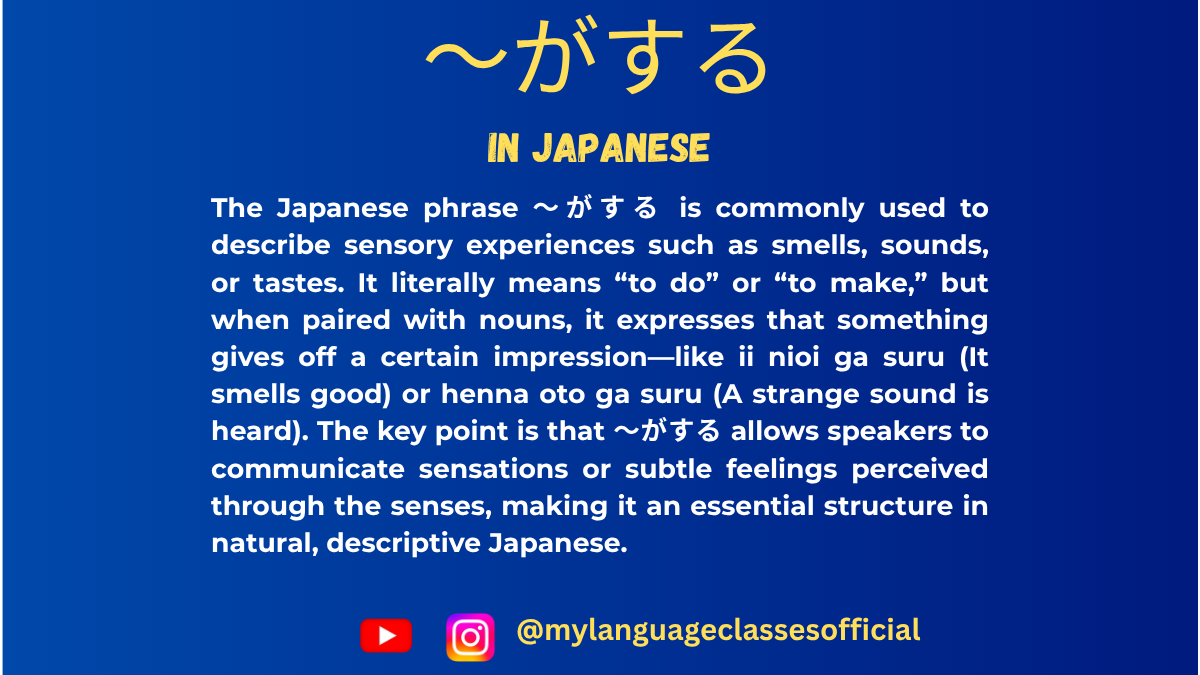
Understanding 〜がする in Japanese | My Language Classes
Understanding the Usage of 〜がする in Japanese
The expression 〜がする is a common grammatical structure in Japanese used to describe perceptions and sensations related to the five senses, as well as intuitive feelings. It is often translated as “to smell,” “to taste,” “to feel,” or “to sound like.” This phrase allows the speaker to express their sensory or emotional experience in a natural way.
Basic Structure of 〜がする
The pattern generally follows this structure:
[Noun] + がする
Here, [Noun] represents something perceived through the senses (such as smell, taste, sound, or feeling). The verb する indicates that the sensation exists.
Situations Where 〜がする is Used
Below are the different contexts where 〜がする is commonly used:
1. Smell (Odor-related Perception)
Used when describing a smell that one perceives.
- 変なにおいがする。 (Henna nioi ga suru.) – “There is a strange smell.”
- 花の香りがする。 (Hana no kaori ga suru.) – “I smell the fragrance of flowers.”
- ガスのにおいがする。 (Gasu no nioi ga suru.) – “It smells like gas.”
2. Taste (Flavor-related Perception)
Used when describing the taste of something.
- 変な味がする。 (Henna aji ga suru.) – “It has a strange taste.”
- この水は鉄の味がする。 (Kono mizu wa tetsu no aji ga suru.) – “This water tastes like iron.”
- 甘い味がする。 (Amai aji ga suru.) – “It tastes sweet.”
3. Sound (Auditory Perception)
Used when describing a sound that one hears.
- ドアの開く音がする。 (Doa no hiraku oto ga suru.) – “I hear the sound of a door opening.”
- 雷の音がする。 (Kaminari no oto ga suru.) – “I hear the sound of thunder.”
- 人の話し声がする。 (Hito no hanashigoe ga suru.) – “I hear people’s voices.”
4. Feeling (Emotional or Intuitive Perception)
Used when describing a feeling, intuition, or an atmosphere.
- 嫌な感じがする。 (Iyana kanji ga suru.) – “I have a bad feeling.”
- 胸騒ぎがする。 (Munasawagi ga suru.) – “I have a premonition (of something bad).”
- ワクワクする感じがする。 (Wakuwaku suru kanji ga suru.) – “I have an exciting feeling.”
5. Physical Sensations (Pain or Bodily Feelings)
Used when describing physical sensations or discomfort.
- 頭が痛い感じがする。 (Atama ga itai kanji ga suru.) – “I feel like I have a headache.”
- 吐き気がする。 (Hakike ga suru.) – “I feel nauseous.”
- 寒気がする。 (Samuke ga suru.) – “I feel chills.”
6. Other Abstract Feelings and Situations
It can be used to describe abstract or indirect experiences.
- あの人は信用できない気がする。 (Ano hito wa shinyou dekinai ki ga suru.) – “I feel like that person is untrustworthy.”
- ここは何か違う感じがする。 (Koko wa nanika chigau kanji ga suru.) – “This place feels different.”
Key Points to Remember
- 〜がする is used to describe sensory experiences, including smell, taste, sound, and physical or emotional feelings.
- It is typically used with nouns related to perception, such as におい (smell), 味 (taste), 音 (sound), 気 (feeling), 感じ (sensation), 痛み (pain), etc.
- It can be used for both literal (real sensory perceptions) and abstract (intuition, atmosphere, emotions) experiences.
- The phrase makes statements subjective, meaning it expresses the speaker’s personal perception rather than an objective fact.
Conclusion
Understanding 〜がする is essential for expressing sensory perceptions naturally in Japanese. Whether you’re describing a delicious meal, a strange smell, an ominous feeling, or an unexpected noise, this structure is an invaluable tool in communication. Mastering its usage will enhance your ability to express experiences vividly and naturally in Japanese.
By practicing various sentence patterns using 〜がする, learners can deepen their understanding and fluency in Japanese conversation. Try using it in your daily observations to get more comfortable with its application!
If you enjoyed this lesson, be sure to check out more posts like this on my blog at My Language Classes. Don’t forget to subscribe my YouTube channel and follow me on Instagram for the latest language learning tips and lessons. Leave a comment below to share your thoughts, or ask any questions you have about nouns.
Happy learning! 😊
-
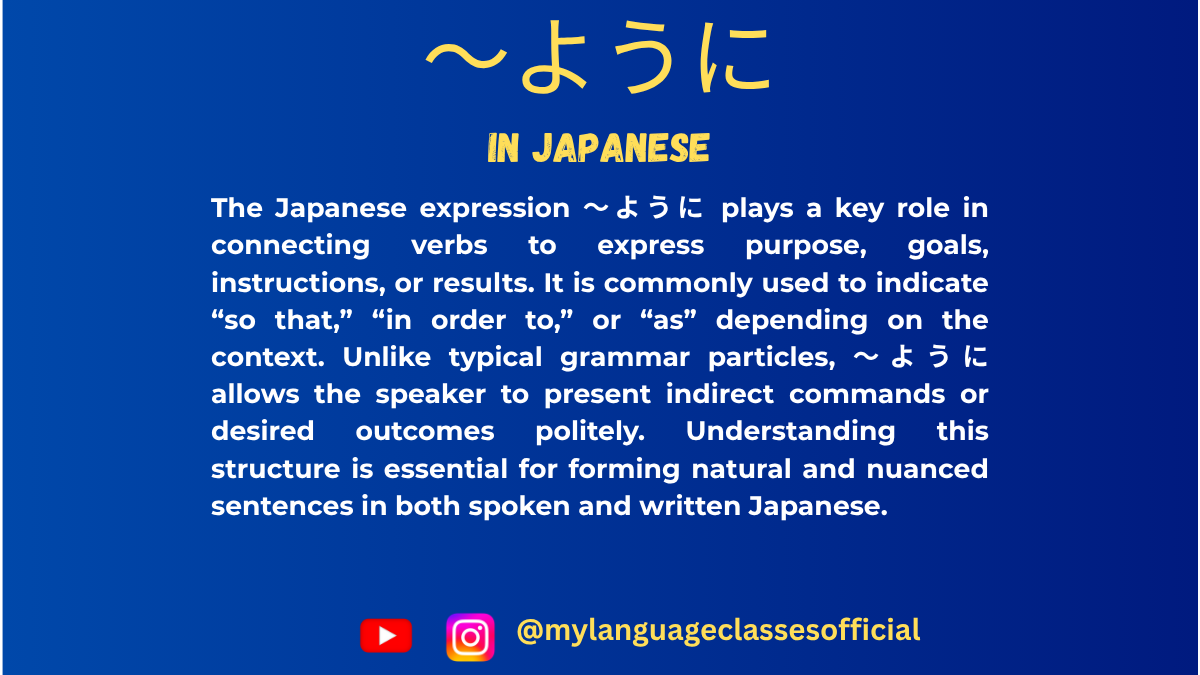
Understanding 〜ように in Japanese | My Language Classes
Using 〜ように in Japanese
The Japanese expression 「〜ように」 is an essential grammatical structure that serves various purposes, including expressing hopes, requests, instructions, comparisons, goals, and habitual actions. This guide will provide an in-depth look at the different uses of 「〜ように」, along with clear explanations and example sentences.
1. Expressing Hopes or Wishes
「〜ように」 is used to express a hope or wish for something to happen, similar to saying “I hope that…” in English.
Structure:
Verb (potential form / negative form) + ように
Examples:
- 試験に合格できますように。
(Shiken ni goukaku dekimasu you ni.)
→ “I hope I can pass the exam.” - 雨が降らないように。
(Ame ga furanai you ni.)
→ “I hope it doesn’t rain.”
2. Expressing Goals or Objectives
This usage is similar to saying “in order to” in English. It indicates a goal or purpose for an action.
Structure:
Verb (potential form / dictionary form) + ように
Examples:
- 日本語が話せるように、毎日勉強しています。
(Nihongo ga hanaseru you ni, mainichi benkyou shiteimasu.)
→ “I study every day in order to be able to speak Japanese.” - 風邪を引かないように、マフラーをします。
(Kaze wo hikanai you ni, mafuraa wo shimasu.)
→ “I wear a scarf so that I don’t catch a cold.”
3. Giving Instructions or Advice (Indirect Commands)
When making polite or indirect requests, suggestions, or advice, 「〜ように」 is often used.
Structure:
Verb (plain non-past form) + ように 言う / 注意する / 頼む / 伝える
Examples:
- 先生は学生に宿題を忘れないように言いました。
(Sensei wa gakusei ni shukudai wo wasurenai you ni iimashita.)
→ “The teacher told the students not to forget their homework.” - 医者に早く寝るように注意された。
(Isha ni hayaku neru you ni chuui sareta.)
→ “The doctor advised me to sleep early.” - 彼に遅刻しないように頼みました。
(Kare ni chikoku shinai you ni tanomimashita.)
→ “I asked him not to be late.”
4. Making Comparisons
When used with verbs like なる (to become), 「〜ように」 can indicate a comparison or similarity.
Structure:
Noun + のように / Verb (plain form) + ように
Examples:
- 彼は先生のように話します。
(Kare wa sensei no you ni hanashimasu.)
→ “He speaks like a teacher.” - この部屋はまるでホテルのように綺麗です。
(Kono heya wa marude hoteru no you ni kirei desu.)
→ “This room is as clean as a hotel.”
5. Indicating Habitual Actions or Natural Consequences
This structure shows that something naturally happens or occurs habitually.
Structure:
Verb (dictionary form / negative form) + ようになる
Examples:
- 毎日練習して、日本語が話せるようになった。
(Mainichi renshuu shite, nihongo ga hanaseru you ni natta.)
→ “After practicing every day, I became able to speak Japanese.” - 最近、早く起きるようになりました。
(Saikin, hayaku okiru you ni narimashita.)
→ “Recently, I have started waking up early.”
6. Expressing Something Indirectly
When introducing a previous statement or explanation, 「〜ように」 can mean “as mentioned before” or “as expected.”
Structure:
Verb (plain form) + ように
Examples:
- 前に話したように、このプロジェクトは重要です。
(Mae ni hanashita you ni, kono purojekuto wa juuyou desu.)
→ “As I mentioned before, this project is important.” - 先生が言ったように、復習することが大切です。
(Sensei ga itta you ni, fukushuu suru koto ga taisetsu desu.)
→ “As the teacher said, reviewing is important.”
7. Expressing a Desired Outcome in a Prayer or Wish
This structure is common in prayers and formal expressions.
Structure:
Verb (potential form / negative form) + ように
Examples:
- みんなが幸せになりますように。
(Minna ga shiawase ni narimasu you ni.)
→ “I hope everyone becomes happy.” - 悪いことが起こらないように。
(Warui koto ga okoranai you ni.)
→ “I hope nothing bad happens.”
Summary: Situations Where 「〜ように」 is Used
Usage Meaning Example Expressing Hopes or Wishes “I hope that…” 試験に合格できますように。 Expressing Goals “In order to…” 日本語が話せるように勉強しています。 Giving Instructions / Advice Indirect commands 先生は学生に宿題を忘れないように言いました。 Making Comparisons “Like…” 彼は先生のように話します。 Indicating Habitual Actions “To become able to…” 日本語が話せるようになった。 Introducing Statements “As mentioned…” 前に話したように、このプロジェクトは重要です。 Expressing Wishes in Prayer Formal wishes みんなが幸せになりますように。
Conclusion
「〜ように」 is a versatile and essential grammar structure in Japanese. Understanding its different uses can greatly enhance your ability to communicate hopes, goals, indirect commands, comparisons, and habitual changes. By mastering this structure, you will sound more natural and fluent in Japanese!
Would you like me to cover any other grammar points in detail? Let me know in the comments!
If you enjoyed this lesson, be sure to check out more posts like this on my blog at My Language Classes. Don’t forget to subscribe my YouTube channel and follow me on Instagram for the latest language learning tips and lessons. Leave a comment below to share your thoughts, or ask any questions you have about nouns.
Happy learning! 😊
- 試験に合格できますように。
-
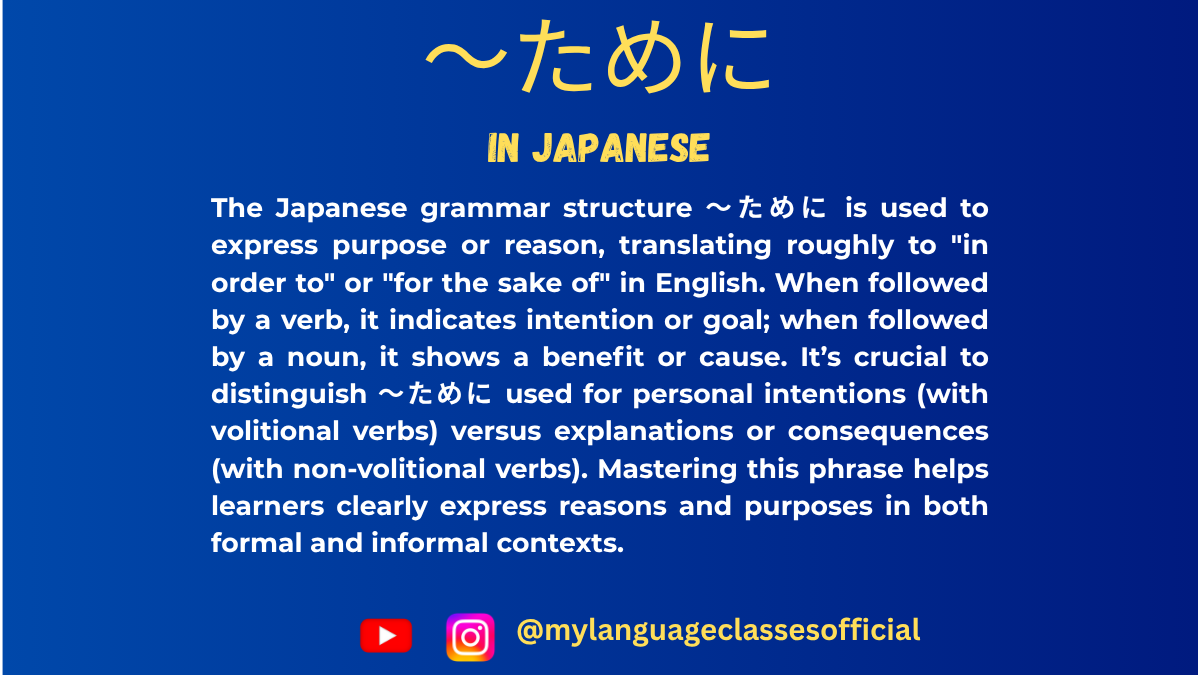
Using 〜ために in Japanese | My Language Classes
Understanding 〜ために in Japanese
In Japanese, “〜ために” (tame ni) is a highly versatile grammatical structure used to indicate purpose, reason, or benefit. Understanding its different meanings and contexts is crucial for mastering the Japanese language.
This article will explain all the possible uses of “ために” along with example sentences and a list of situations where it is commonly used.
**1. Expressing Purpose (目的)
The most common use of “ために” is to express purpose or intention. In this case, it is used with dictionary form verbs or nouns.**
Structure:
- Verb (dictionary form) + ために
- Noun + の + ために
Examples:
- 体重を減らすために歩いています。 (I walk in order to lose weight.)
- 簡単な日本語を勉強するためにこのアプリを使う。 (I use this app to study simple Japanese.)
- 健康のために毎日ヨガをしています。 (For my health, I do yoga every day.)
Note:
- “ために” is used for intentional actions performed by someone with a goal in mind.
2. Expressing Reason or Cause (原因)
“ために” can also be used to express a reason or cause for a particular event, similar to “because of” in English.
Structure:
- Verb (plain past form) + ために
- Noun + の + ために
Examples:
- 天気が悪かったためにゲームが中止された。 (Because of bad weather, the game was canceled.)
- 病気のために休んだ。 (I took a break because of illness.)
- 仕事が大変だったためにとても疲れています。 (Because work was difficult, I am very tired.)
Note:
- In this case, the outcome is not controlled by the speaker and is often negative.
3. Expressing Benefit or Effect (利益)
Another meaning of “ために” is to indicate the benefit or positive effect of something.
Structure:
- Noun + の + ために
Examples:
- 子供のために私たちは最良の教育を提供したい。 (For the benefit of children, we want to provide the best education.)
- 世界のために安全な環境を作りましょう。 (For the benefit of the world, let’s create a safe environment.)
Note:
- This use of “ために” is often found in formal speech, policies, and slogans.
4. “ために” vs. “ように” (Comparison)
Both “ために” and “ように” express purpose, but they have different uses:
Phrase Used with Meaning ために Dictionary-form verbs (intentional) Purpose (the subject can control the action) ように Potential-form verbs or non-intentional actions Purpose (the subject cannot directly control the action) Examples:
- ために: 体重を減らすために歩いています。 (I walk in order to lose weight.)
- ように: 日本語を話せるように勉強している。 (I study so that I can speak Japanese.)
Key difference: “ために” is used when the subject can control the outcome, while “ように” is used for situations where the outcome depends on ability or an external factor.
Situations Where 〜ために is Used
Situation Example Expressing Purpose 旅行するためにお金を貯めています。 Expressing Reason 天気が悪かったためにコンサートが中止された。 Expressing Benefit 社会のために活動しています。
Conclusion
The structure “ために” is an essential part of Japanese grammar, used to express purpose, reason, and benefit. Mastering its different uses will greatly improve your ability to form complex and meaningful sentences in Japanese.
Understanding the differences between “ために” and similar expressions like “ように” will help you sound more natural in Japanese conversations. Keep practicing and using “ために” in different contexts!
If you enjoyed this lesson, be sure to check out more posts like this on my blog at My Language Classes. Don’t forget to subscribe my YouTube channel and follow me on Instagram for the latest language learning tips and lessons. Leave a comment below to share your thoughts, or ask any questions you have about nouns.
Happy learning! 😊
-
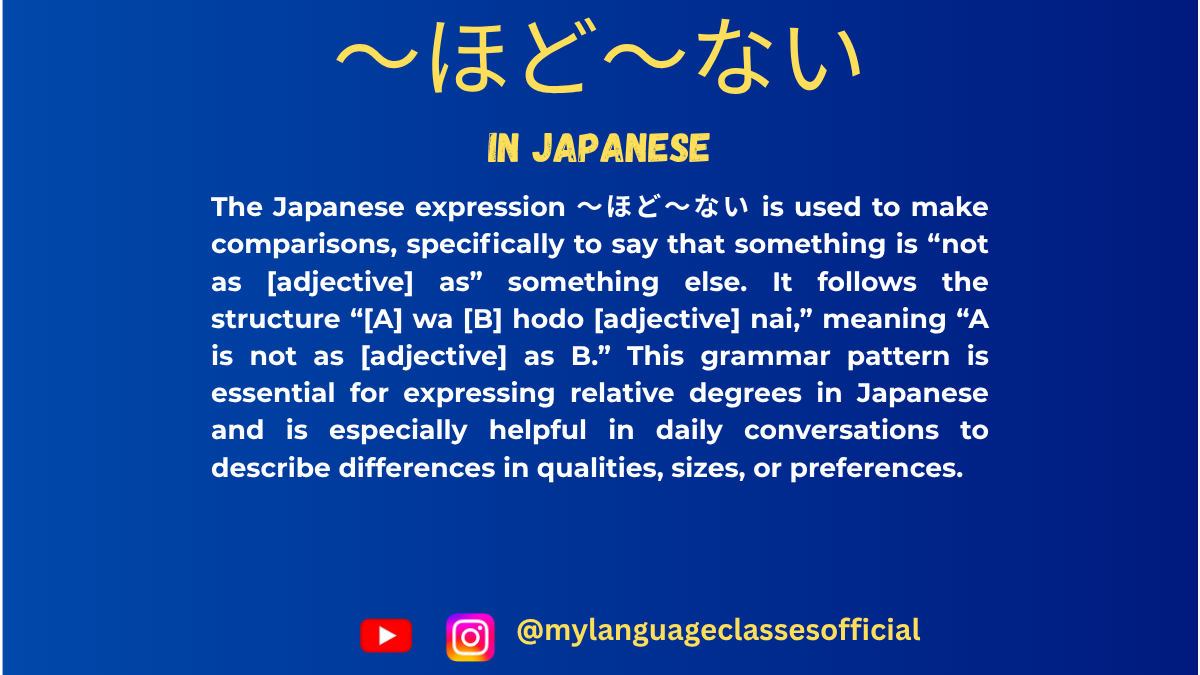
Using 〜ほど〜ない in Japanese | My Language Classes
Understanding 〜ほど〜ない in Japanese
The Japanese grammar pattern 「〜ほど〜ない」 is commonly used for making comparisons and expressing degree or extent. It implies that something is “not as much as” something else. This phrase is often translated as “not as… as…” in English.
Basic Structure of 〜ほど〜ない
The structure of this grammar pattern is as follows:
Noun + ほど + Adjective (ない-form)
or
Verb (dictionary form) + ほど + Adjective (ない-form)
General Meaning
「A ほど B ない」 means that B is not as A.
- A is the standard of comparison.
- B is the thing being compared.
Examples:
- この町は東京ほど賑やかではない。
(Kono machi wa Tōkyō hodo nigiyaka de wa nai.)
→ This town is not as lively as Tokyo. - 彼は私ほど速く走れない。
(Kare wa watashi hodo hayaku hashirenai.)
→ He cannot run as fast as I do. - この問題は思ったほど難しくない。
(Kono mondai wa omotta hodo muzukashiku nai.)
→ This problem is not as difficult as I thought.
Situations Where 〜ほど〜ない is Used
1. Comparing Extent or Degree
- Used when two things are compared, but the second one (B) has less intensity than the first (A).
Example:
北海道の冬は東京の冬ほど寒くない。
(Hokkaidō no fuyu wa Tōkyō no fuyu hodo samuku nai.)
→ Hokkaido’s winter is not as cold as Tokyo’s winter.2. Expressing Subjective Opinions
- Often used to express personal opinions about differences in perception.
Example:
数学は国語ほど難しくないと思います。
(Sūgaku wa kokugo hodo muzukashiku nai to omoimasu.)
→ I think math is not as difficult as Japanese.3. Negative Comparison in Abilities or Characteristics
- Used when comparing someone’s ability or characteristics with another’s.
Example:
彼の英語は先生ほど上手ではない。
(Kare no eigo wa sensei hodo jōzu de wa nai.)
→ His English is not as good as the teacher’s.4. Comparing Expectations vs Reality
- Used when expectations were high, but the actual situation is not as expected.
Example:
この映画は評判ほど面白くない。
(Kono eiga wa hyōban hodo omoshiroku nai.)
→ This movie is not as interesting as its reputation suggests.5. Comparing Feelings and Emotions
- Used when talking about feelings that are not as strong as expected.
Example:
彼は私が思ったほど優しくない。
(Kare wa watashi ga omotta hodo yasashiku nai.)
→ He is not as kind as I thought.6. Comparing Physical Condition or Health
- Used to compare health conditions or physical states.
Example:
風邪は思ったほどひどくない。
(Kaze wa omotta hodo hidoku nai.)
→ The cold is not as bad as I thought.7. Comparing Amount or Frequency
- Used when comparing quantity or frequency of actions.
Example:
今日は昨日ほど忙しくない。
(Kyō wa kinō hodo isogashiku nai.)
→ Today is not as busy as yesterday.8. Comparing Importance or Necessity
- Used when comparing levels of importance or necessity.
Example:
宿題はテストほど大事ではない。
(Shukudai wa tesuto hodo daiji de wa nai.)
→ Homework is not as important as tests.9. Comparing Strength of Desire or Preference
- Used to compare desires, preferences, or interests.
Example:
私は映画を見るのが好きですが、本を読むほど好きではない。
(Watashi wa eiga o miru no ga suki desu ga, hon o yomu hodo suki de wa nai.)
→ I like watching movies, but not as much as reading books.
Key Points to Remember About 〜ほど〜ない
- It is used for making comparisons where the second element has less intensity.
- It is often used to express subjective opinions.
- It is used to compare expectations vs reality.
- It can be used in various contexts: ability, frequency, amount, physical conditions, and emotions.
- It follows a simple pattern: “A ほど B ない”, where A is the standard, and B is the thing being compared.
Conclusion
The 「〜ほど〜ない」 grammar pattern is an essential part of Japanese when making negative comparisons. Mastering it will help you express your opinions, compare things effectively, and sound more natural in conversations. Make sure to practice using this structure in daily life to reinforce your understanding!
If you enjoyed this lesson, be sure to check out more posts like this on my blog at My Language Classes. Don’t forget to subscribe my YouTube channel and follow me on Instagram for the latest language learning tips and lessons. Leave a comment below to share your thoughts, or ask any questions you have about nouns.
Happy learning! 😊

